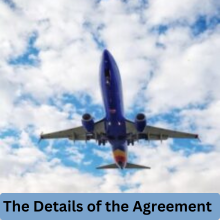
As climate change continues to pose challenges for industries worldwide, aviation is stepping up its game. Southwest Airlines has just announced a groundbreaking partnership that aims to reduce its carbon footprint by introducing sustainable aviation fuel (SAF) at Chicago Midway International Airport (MDW). This move is not just a win for the airline but also a significant step toward a greener future for air travel.
The Need for Sustainable Aviation
Air travel is essential for connecting people and businesses, but it comes at a cost to our environment. Traditional jet fuel contributes significantly to greenhouse gas emissions. As public awareness grows, the demand for cleaner alternatives has skyrocketed. Southwest’s new SAF initiative reflects a broader industry trend toward sustainability.
Overview of the Agreement
The partnership with Valero Marketing and Supply Company marks one of the largest SAF supply agreements in Illinois. Over two years, Southwest aims to purchase 3.6 million gallons of neat SAF—equating to about 12 million gallons when blended. They also have the option to acquire up to 25 million gallons over the agreement’s term. This substantial commitment speaks volumes about the airline’s dedication to sustainable practices.
What is Sustainable Aviation Fuel (SAF)?
Definition and Benefits
Sustainable Aviation Fuel is a renewable alternative to conventional jet fuel. Made from various waste-based feedstocks like used cooking oil and animal fat, SAF significantly reduces lifecycle greenhouse gas emissions. In fact, studies show it can cut emissions by 74% to 84% compared to traditional fuels. This isn’t just a marketing ploy; it’s a necessary shift toward more responsible flying.
How SAF is Produced
The production of SAF involves converting waste materials into fuel through advanced technologies. By using feedstocks that would otherwise contribute to waste, SAF not only reduces emissions but also promotes a circular economy. It’s like turning yesterday’s leftovers into a gourmet meal—innovative and sustainable!
The Details of the Agreement
Quantity and Timeline
Under the agreement, Southwest plans to begin using SAF as early as Q4 2024. The 3.6 million gallons of neat SAF will play a crucial role in their operations, enabling the airline to lead the way in sustainability at MDW.
Blending Process with Conventional Fuel
This SAF will be blended with Valero’s conventional jet fuel before distribution. The blending process will utilize existing fuel delivery infrastructure, making it efficient and scalable. This means that the transition to SAF can happen seamlessly, without requiring extensive new infrastructure.
Also read: Get Ready! The McRib Returns with a Surprising Twist!
The Impact on Chicago Midway International Airport
A Step Towards Cleaner Air Travel
Chicago Midway International Airport is one of the busiest airports in the U.S. By integrating SAF into its fuel supply, it can significantly reduce its environmental impact. This is a massive step toward cleaner air travel—not just for Chicago but for the entire aviation industry.
Economic Implications for Illinois
Beyond environmental benefits, this agreement also has economic implications for Illinois. The SAF initiative could create jobs in the state, particularly in renewable energy sectors. With the backing of the state government, this move can stimulate local economies while promoting sustainability.
Government Support for SAF
Illinois’ Commitment to Sustainability
Governor JB Pritzker has emphasized his commitment to making Illinois a leader in sustainability and clean energy. His support for a SAF tax credit has already shown positive impacts on adoption rates in the state. It’s clear that local governments are taking proactive steps to foster a sustainable future.
Federal Support for SAF Initiatives
At the federal level, lawmakers like Senator Tammy Duckworth are pushing for increased SAF supply. This bipartisan support aims to bolster domestic production, ensuring that American farmers and blenders benefit while reducing the nation’s carbon footprint. It’s a win-win scenario for everyone involved.
Also read: Shocking Reasons Behind Meta’s $400K Employee Termination: Toothpaste and Tea?
Environmental Benefits of SAF
Lifecycle Emission Reductions
One of the most significant advantages of SAF is its ability to drastically reduce lifecycle emissions. The switch from conventional jet fuel to SAF represents a tangible way for airlines to contribute to climate goals. With the aviation sector under pressure to decarbonize, SAF offers a practical solution.
Comparison with Conventional Jet Fuel
Unlike traditional jet fuel, which is derived from fossil fuels, SAF is renewable and can be produced sustainably. This shift not only minimizes the environmental impact but also aligns the airline industry with global sustainability goals.
Industry Reactions and Expectations
Responses from Government Officials
The announcement has garnered praise from various sectors. Governor Pritzker and Senator Duckworth have both commended Southwest for taking this important step. Their reactions highlight the broader significance of this initiative in promoting sustainable aviation.
What This Means for Airlines and Travelers
For airlines, adopting SAF could set a new standard in operational practices. For travelers, this could mean a more eco-friendly flying experience. Imagine boarding a plane knowing that your travel contributes to a cleaner planet—it’s a game-changer.
Challenges and Opportunities Ahead
Current Barriers to SAF Adoption
While the news is promising, challenges remain. The cost of producing SAF is generally higher than traditional jet fuel, which can deter airlines from making the switch. Additionally, there are questions about scalability and supply chain logistics that need to be addressed.
Future Prospects for the Aviation Industry
However, the opportunities are vast. As technology advances and production methods become more efficient, the costs of SAF will likely decrease. This could pave the way for wider adoption across the industry, ultimately making air travel more sustainable.
Conclusion
Southwest Airlines’ initiative to introduce sustainable aviation fuel at Chicago Midway International Airport marks a pivotal moment in the aviation industry. Not only does it demonstrate the airline’s commitment to sustainability, but it also sets a precedent for others to follow. With ongoing support from government officials and advancements in SAF technology, we can hope for a greener future in air travel.
FAQs
What is SAF made from?
SAF is primarily made from waste-based feedstocks like used cooking oil, animal tallow, and distiller’s corn oil.
How does SAF impact ticket prices?
Currently, SAF is more expensive to produce than traditional fuel, which may lead to slightly higher ticket prices, but economies of scale could help lower costs in the future.
Is SAF safe for all aircraft?
Yes, SAF is compatible with existing jet engines and can be used without modifications.
How widespread is the use of SAF in the U.S.?
While SAF use is still emerging, several airlines are beginning to adopt it, and government support is growing, indicating a promising future.
What are the long-term benefits of using SAF?
Long-term benefits include reduced greenhouse gas emissions, a smaller carbon footprint for airlines, and support for renewable energy sectors.

